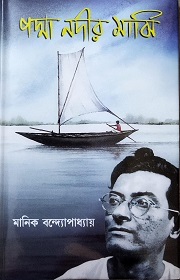Padma Nadir Majhi
A Hindu fisherman from a village along India's Padma River faces a decision that could drastically change his family's destiny when a wealthy Bengali Muslim trader invites him to move to the utopian island he has created
Manik Bandopadhyay's writing was inspired by both Marxian philosophy and Freudian philosophy - which are quite contrasting in nature. His writing stands in stark contrast to that of other contemporary luminaries like Bibhutibhushan Bandopadhyay who portrayed life in rural Bengal in a gentle, lyrical light
Manik Bandopadhyay's writing was inspired by both Marxian philosophy and Freudian philosophy - which are quite contrasting in nature. His writing stands in stark contrast to that of other contemporary luminaries like Bibhutibhushan Bandopadhyay who portrayed life in rural Bengal in a gentle, lyrical light
Shortly after making his debut in the world of fiction in 1935 through a short story titled Atshi Mami, Manik Bandopadhay embarked upon writing novels. Publication of Diba-Ratrir Kabya in 1935 and Padma Nadir Majhi and Putul Nacher Itikotha in 1936 established him as the most notable novelist Bengali literature since Bankimchandra, Rabindranath and Saratchandra. He distinguished himself with focus on the life of ordinary rural and urban people, with colloquial language and with a neat narrative. He was a great storyteller who perfected his fiction with insight into human mind. In the earlier works he took a Freudian approach. In the later life, he showed influence of Marxist theory. His treatment of human sexuality in Chatushkone is path-breaking.
Manik Bandopadhyay's writing was inspired by both Marxian philosophy and Freudian philosophy - which are quite contrasting in nature. His writing stands in stark contrast to that of other contemporary luminaries like Bibhutibhushan Bandopadhyay who portrayed life in rural Bengal in a gentle, lyrical light
Shortly after making his debut in the world of fiction in 1935 through a short story titled Atshi Mami, Manik Bandopadhay embarked upon writing novels. Publication of Diba-Ratrir Kabya in 1935 and Padma Nadir Majhi and Putul Nacher Itikotha in 1936 established him as the most notable novelist Bengali literature since Bankimchandra, Rabindranath and Saratchandra. He distinguished himself with focus on the life of ordinary rural and urban people, with colloquial language and with a neat narrative. He was a great storyteller who perfected his fiction with insight into human mind. In the earlier works he took a Freudian approach. In the later life, he showed influence of Marxist theory. His treatment of human sexuality in Chatushkone is path-breaking.
You need to log in to Rate the book
Top rated books in this category
Other books by the same author
Those who have read this book also read these books


































